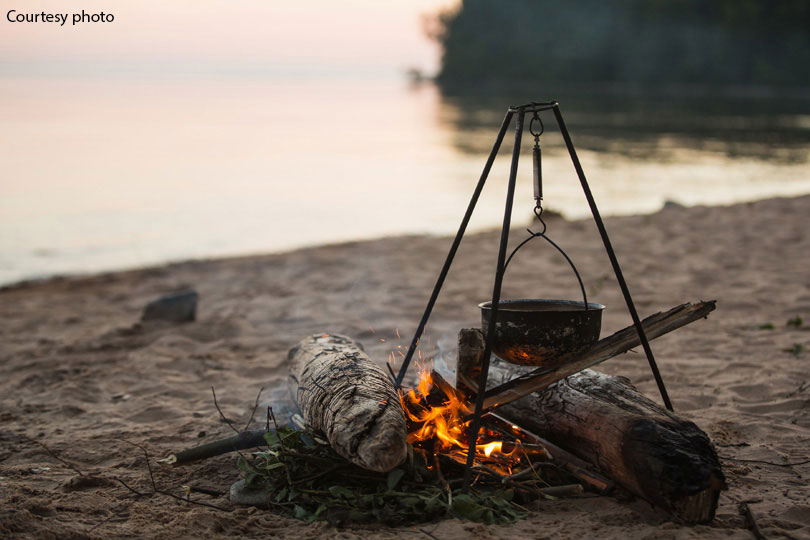By Jessica Domel
Multimedia Reporter
Although recent rainfall has improved drought conditions across much of the state, the risk of wildfire remains—prompting Texas A&M Forest Service to remind hunters to help prevent wildfires this fall and winter.
“We have had some rain, but something to keep in mind going into the fall and winter seasons, is once we start getting our frosts and our hard freezes, our grasses go dormant. That’s when all our grasses start turning brown,” Karen Stafford, the forest services’ statewide wildfire prevention program coordinator, said. “They dry out very quickly. They’re very susceptible to ignition, and they carry a fire very easily. That’s a major change in our vegetation—rain or no rain.”
To prevent a wildfire from igniting dry vegetation, the Forest Service urges drivers to ensure nothing is dragging from their vehicle or trailer.
“While people are taking their equipment out to their deer leases—feeders, four-wheelers or anything like that—always inspect those tow chains where the trailer connects to the vehicle,” Stafford said in an interview with the Texas Farm Bureau Radio Network. “Make sure those chains are not making contact with the road surface because that will cause sparks, and it can ignite a grass fire.”
Avoid driving, idling and parking vehicles on vegetation as the underside of a vehicle can get very hot and ignite a fire.
“Equipment causes about 18% of our wildfires this time of year and that could be just as simple as parking on dry grass,” Stafford said. “Whether you’re using your normal vehicles, ATVs, UTVs or anything that has a catalytic converter underneath it, that catalytic converter becomes so hot that when it contacts dry grass, it can ignite a fire. Something as simple as making sure you have a clearance down to the soil underneath where you park, or just staying on designated parking areas, that’ll help a lot.”
During hunting season, campfires are responsible for about 2% of wildfires in Texas.
Those who plan to light a campfire should make sure the area where the fire will be set is entirely clear of flammable materials.
“This time of year, everybody wants a campfire—whether they’re just keeping warm or cooking outside,” Stafford said. “Make sure those campfires have a clearance all the way around them down to the soil, so the fire can’t escape the fire ring. Make sure that fire is fully extinguished either before you leave your campsite or go to bed at night. Always have a water source on hand and completely extinguish those fires until the coals are cold.”
A campfire should be kept at a manageable size and never left unattended.
“If the winds pick up during the day while you’ve gone out hunting, those winds could carry the fire embers out of your fire into the brush or into the leaves outside the fire ring,” Stafford said.
Before leaving camp, ensure the fire is completely out.
“We say drown, stir, drown, stir and feel,” Stafford said. “We’re going to drown the fire with water. We’re going to stir those hot coals. We’re going to drown it again with more water. Stir the hot coals. Then, you can put the back of your hand down close to the coals. If you feel heat, then we need to repeat.”
Stafford also urges people who plan on starting an outdoor fire to ensure the county they are in is not under a burn ban.
“If you’re traveling to a deer lease that’s on the other side of the state, make sure you’re aware of the conditions of where you’re going, not just what the conditions were at home when you left,” Stafford said.
As of Nov. 6, 80 counties in Texas remain under burn bans.
Hunters should also be careful when using high-velocity ammunition, or ammunition with a steel core, when fire danger is high.
“It heats up and that can ignite the dry grass if it strikes it,” Stafford said. “Also, if you’re shooting into rocks, that steel core will strike the rock and cause a spark.”
Exploding targets should not be used in an area with tall grasses or with overhanging vegetation.
Hunters aren’t the only Texans who should be mindful of fire danger this time of year. People who plan to work outdoors on equipment, clear brush or anything that can create a spark are asked to use caution.
“We have a lot of fires that are caused by welding in Texas,” Stafford said. “Have a spotter nearby that’s watching for the sparks while you’re welding. Have that spotter watching for the sparks and where they land. Make sure you’re not welding around dry grass. Avoid welding on windy days because that wind can carry those sparks and those embers into the dry grass. Again, keep a water source on hand, whether that be with a hose, a bucket or a fire extinguisher.”
People should also ensure the fire extinguishers they have are up-to-date and still charged.
In the fall and winter, 75% of fires in Texas are caused by debris burning. Five percent are caused by arson.
Those heading to food cookoffs, events or another location towing lit barbecue pits should also use caution.
“A lot of people like to drag their barbecue pits down the highway while they’re cooking their food at the same time. If you have those hot coals dropping out of the bottom of your barbecue pit, those could also easily ignite a fire, as well,” Stafford said.
Driving on flat tires and allowing vehicle rims to strike the road, and bad trailer brakes can also create sparks that can ignite a wildfire.
If you see a wildfire, the best thing to do is call 9-1-1.
“Just immediately call 9-1-1. Don’t put yourself at risk. Don’t think you can manage it on your own. Just go ahead and let the professionals be there to take care of you,” Stafford said.

